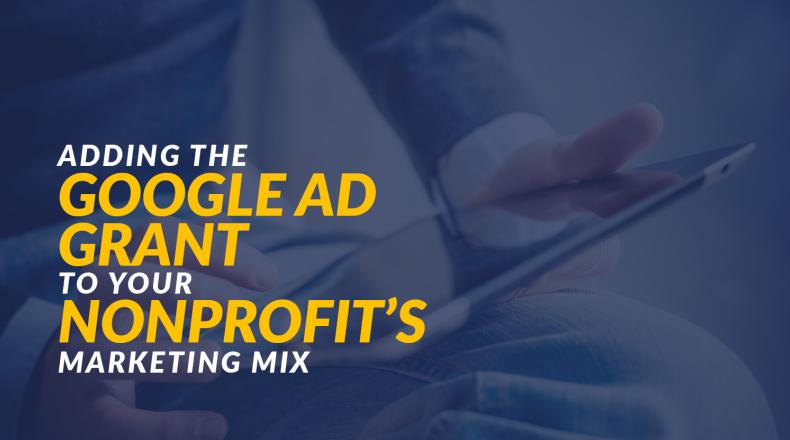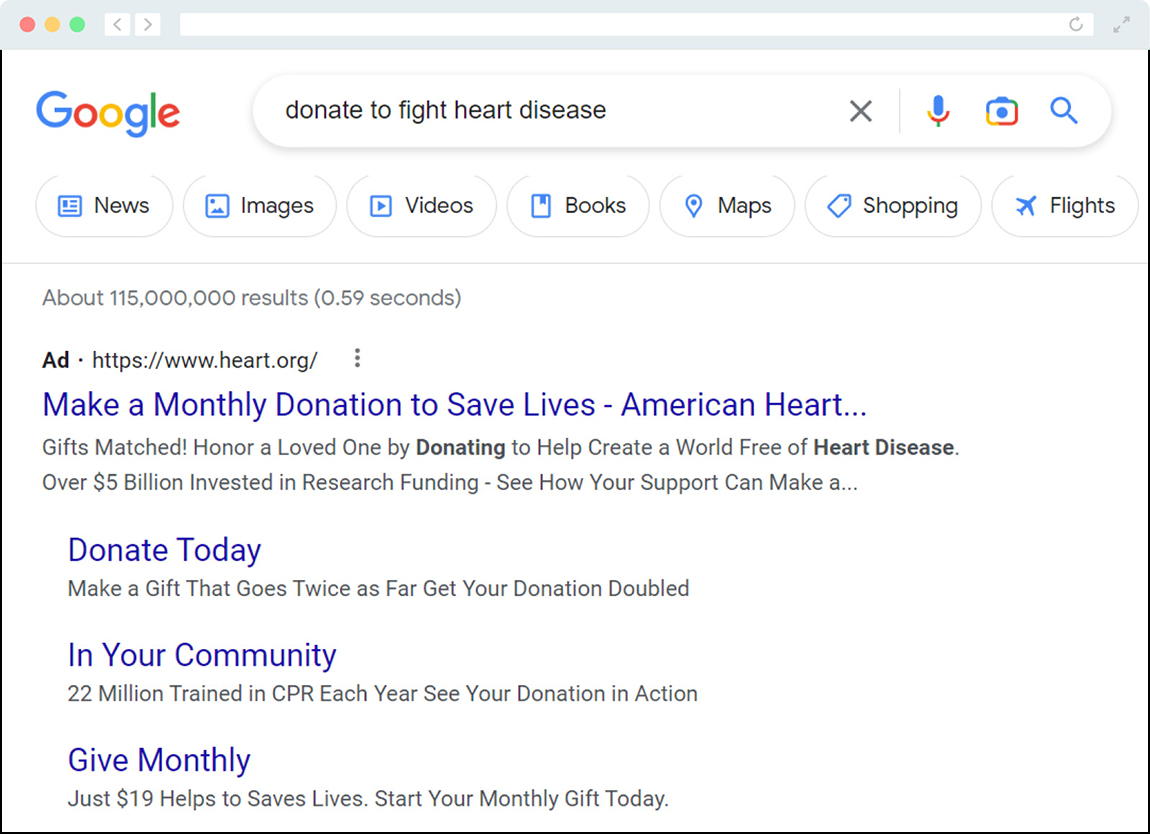Adding The Google Ad Grant To Your Nonprofit's Marketing Mix

Imagine a grant that can boost your online visibility, increase website traffic, and engage your target audience. Enter the Google Ad Grant, a game-changing program meant to elevate nonprofits’ marketing.
The Google Ad Grant program supplies eligible nonprofits with $10,000 in free advertising every month. As long as you follow the program’s requirements and rules, you’ll be approved, and the grant will renew each month. Since its creation, nonprofit reports show the program has given over $9 billion in free advertising to more than 115,000 nonprofits.
While free advertising money is a plus, you’re probably wondering how the grant will fit into your nonprofit’s marketing mix. How can it support your nonprofit’s mission? Will it work with your other marketing channels and strategies? We’ll cover all that and more by exploring the following:
- How The Grant Supports Your Marketing Goals
- Identifying Your Target Audience
- Developing Standout Ads
- Integrating Google Ad Grant Campaigns With Other Marketing Channels
With strategic implementation, the Google Ad Grant can contribute to a comprehensive marketing strategy. Ready to enhance your online presence? Let’s dive in!
How The Grant Supports Your Marketing Goals
One of the best parts of the Google Ad Grant is its versatility. You can spend your ad credits on amplifying almost any helpful content on your site. That means you can promote everything from your donation form to blog posts.
While the program will naturally drive website traffic, the real advantages come when you inspire people to act. Getting Attention’s Google Ad Grants guide shares some common action-based goals nonprofits achieve with the program, such as:
- Drive donations by amplifying donation and campaign pages
- Educate the public by promoting educational content
- Increase event registrations for upcoming 5Ks, webinars, galas, and other gatherings
- Boost volunteerism by sharing volunteer content
- Grow your email marketing list by encouraging new sign-ups
- Increase memberships by sharing member information pages
Use the Google Ad Grant to supercharge your nonprofit’s marketing performance by sharing the right content with the right audiences to achieve these goals.
Identifying Your Target Audience
After defining your goals, focus on your ads’ target audience. Chances are, you’ve already defined your audience as part of your nonprofit’s existing marketing efforts. If not, you can start by looking at individuals who’ve historically engaged with your outreach.
Let’s say your nonprofit focuses on environmental conservation. To determine your target audience for Google Ads, define the characteristics of the individuals who are most likely to support your cause. Based on past outreach, you might determine their shared aspects include the following:
- Age group: Young adults ages 25-35
- Interests: Individuals passionate about environmental issues, nature, and eco-friendly practices
- Geographic location: Urban and suburban areas within the United States that have high concentrations of environmentally-aware individuals
- Behavior: Active internet users who engage with environmental content and support eco-friendly businesses
Thorough prospect research comes in handy here! Google even enables targeting features to display ads to relevant users based on demographics and geographic location.
Knowing your target audience, put yourself in their shoes to ensure your ads are displayed to likely supporters. And when you get those ads in front of them, make sure they’ll grab their attention.
Developing Standout Ads
Aim to craft compelling messages that resonate with your target audience. This requires choosing keywords that support your marketing objectives. Brainstorm potential keywords your target audience might search on Google.
Sticking to our previous example, let’s say you’re attempting to increase digital donations to your environmental conservation efforts. Taking the perspective of your target audience, you might look into keywords such as “give to environmental conservation,” “support green initiatives,” or “donate to protect nature.”
Use your Google Ads keyword research tool to gather analytics for these terms. With Google Keyword Planner, you can see helpful information such as:
- Search traffic to determine whether individuals are searching for these terms
- Competition level to assess the difficulty of ranking for specific keywords
- Cost-Per-Click (CPC) estimates to see estimated bid ranges
- Keyword ideas to find similar keywords people search
After selecting keywords, craft ads that’ll speak to these searchers. Look into content on your other marketing channels that elicited positive responses. Perhaps stories about specific types of animals perform well on social media. Or, maybe your email subscribers enjoy receiving statistics-backed updates regarding your deforestation prevention efforts.
By analyzing past engagement, you can determine what inspires supporters and drives them to donate, volunteer, or take other meaningful actions. Then, emulate similar messaging in your Google Ads.
An Example of a Standout Ad
Double the Donation’s nonprofit advertising guide provides an excellent example of targeting your audience with inspiring messaging via Google Ads.

In the example above, the American Heart Association (AHA) targeted keywords like “donate to fight heart disease.” The ad works for a handful of reasons:
- Users who search for donation-related terms are likely to give.
- The landing pages correlate with the ad’s message and the searcher’s intent.
- AHA has a handful of giving-focused pages, including pages about monthly giving, a donation form, and a page showing the impact of donations.
- AHA clearly knew its audience and aligned its ad to serve supporters’ needs. Using advanced techniques like ad extensions, the nonprofit created a compelling ad that inspired its audience to engage with its content.
Integrating Google Ad Grant Campaigns With Other Marketing Channels
A comprehensive nonprofit marketing strategy requires determining how different channels work together to reach your audience. This includes the Google Ad Grant.
With a careful strategy, the Google Ad Grant can integrate seamlessly with your other digital channels. Here are a few areas in which your Google Ads and other outlets can support each other:
- Grow your email subscriber list by setting your email newsletter sign-up form as your landing page for a Google Ad campaign.
- Drive traffic to your social media pages by featuring social media links on your site, such as in the navigation bar or footer.
- Ensure your Google Ads align with your website’s content so your landing pages and ads are relevant to one another.
- Leverage audience and performance data from your Google Ads to optimize other marketing initiatives and vice versa.
- Promote your Google Ads campaigns on social media by sharing snippets and encouraging followers to engage when they see your ads.
As you integrate your marketing channels, maintain consistent messaging across each outlet. This consistency will reinforce your messages and build brand recognition. By integrating your Google Ads with other marketing channels, your nonprofit can establish a cohesive brand presence and engage its target audience across multiple touchpoints.
Final Thoughts
Adding the Google Ad Grant to your nonprofit’s marketing mix is a no-brainer. It’s free advertising money that can bolster your brand’s digital presence. Whether you want to grow your volunteer numbers or strengthen your other marketing channels, the Google Ad Grant program is a powerful marketing tool. You just need to consider its role in your nonprofit’s marketing to maximize its potential.
 Jessica King is the business lead at Getting Attention, where she helps nonprofits acquire and manage the Google Ad Grant to expand their impact. Prior to her work at Getting Attention, Jessica worked at nonprofits and higher education organizations where she focused on communication and digital marketing. Most recently, she worked in search engine optimization in the mission-driven sector.
Jessica King is the business lead at Getting Attention, where she helps nonprofits acquire and manage the Google Ad Grant to expand their impact. Prior to her work at Getting Attention, Jessica worked at nonprofits and higher education organizations where she focused on communication and digital marketing. Most recently, she worked in search engine optimization in the mission-driven sector.
Jessica holds a master's degree in communication from Virginia Tech. In her free time, you can find her reading, building furniture, and hanging out with her cats, Benny and Olive.

